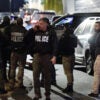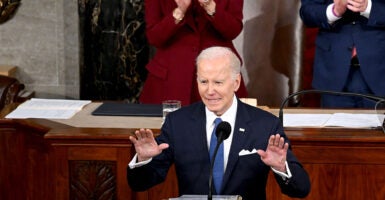During his State of the Union address Tuesday night, President Joe Biden celebrated how far the country has come since the COVID-19 pandemic-induced recession, but he also referenced the Jan. 6 Capitol riot, repeating his claim that it was the “greatest threat” to American democracy since the Civil War.
He noted that his second State of the Union address comes two years after the riot.
“And two years ago, our democracy faced its greatest threat since the Civil War,” Biden said. “Today, though bruised, our democracy remains unbowed and unbroken.”
It’s not clear what he meant in comparing the Capitol riot, in which 950 Donald Trump supporters were charged with crimes, to a war in which several slave-holding Southern states attempted to form a new Confederate States of America, raised their own military in an armed rebellion that wore on for four years, and took the lives of more than 600,000 troops.
During the Capitol riot, hundreds of Trump supporters breached the U.S. Capitol to prevent Congress from certifying Biden’s Electoral College victory over Trump. Several were violent toward police officers and shouted threats at members of Congress and Vice President Mike Pence. Others caused property damage.
Some rioters carried Confederate battle flags into the Capitol on Jan. 6. None of the 950 people arrested were charged with insurrection, or attempting to violently overthrow the government, but federal prosecutors did charge 50 with conspiracy. Out of those, four were convicted of seditious conspiracy. The others were charged with conspiracy to obstruct a congressional proceeding, conspiracy to obstruct law enforcement during a civil disorder, or conspiracy to injure an officer.
Biden didn’t explain why this riot supposedly represented a larger threat to democracy than when Japan attacked the United States on Dec. 7, 1941, which pulled the U.S. into World War II in opposition to the Axis powers.
Further, the Capitol was attacked at least four times before Jan. 6, 2021, three of those times after the Civil War.
In 1814, British soldiers burned the Capitol during the War of 1812. It took about five years to rebuild the House chamber.
In 1954, four Puerto Rican terrorists—Andres Figueroa Cordero, Lolita Lebrón, Irvin Flores Rodríguez, and Rafael Cancel Miranda—attacked the Capitol. Unlike those who got inside the Capitol building in 2021, these terrorists were armed with guns. The four opened fire from the House gallery, wounding five lawmakers: Reps. Alvin Bentley, Ben Jensen, Clifford Davis, George Hyde Fallon, and Kenneth Roberts.
In 1971, a domestic terrorist group called the Weather Underground bombed the Capitol, causing $300,000 worth of damage. No one was harmed. The so-called Weathermen returned in 1983 and set off another bomb that “tore through the second floor of the Capitol’s north wing,” according to the Senate’s history site. No fatalities occurred in this case either.
During the Jan. 6, 2021, attack on the Capitol, several rioters were carrying pepper spray or bear spray, and wielding flagpoles as clubs in attacking law enforcement officers.
Two people died directly from the violence on Jan. 6, 2021, but as many as seven others died indirectly from the events of the day, based on a tally of deaths published in The New York Times.
Have an opinion about this article? To sound off, please email [email protected] and we will consider publishing your remarks in our regular “We Hear You” feature.































